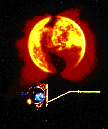
The Ulysses mission is a joint mission with NASA and ESA to explore the
solar environment at high ecliptic latitudes. It was launched 6 October
1990, and reached Jupiter for its "gravitational slingshot" in February
1992. It passed the south solar pole in June 1994 and crossed the ecliptic
equator in February 1995. In addition to its solar environment instruments,
Ulysses also carries plasma instruments to study the interstellar and Jovian
regions, as well as two instruments for studying X-rays and gamma-rays of both
solar and cosmic origins.
The Ulysses spacecraft can operate in 4 different telemetry modes: 128,
256, 512, and 1024 b/s. The time resolution of the gamma-ray burst instrument
varies with the spacecraft data rate. The maximum telemetry allocation for
the instrument is 40 b/s.
The Ulysses solar X-ray and cosmic gamma-ray burst experiment (GRB) has 3 main
objectives: study and monitor solar flares, detect and localize cosmic
gamma-ray bursts, and in-situ detection of Jovian aurorae. Ulysses is the
first satellite carrying a gamma burst detector which went outside the
orbit of Mars. This results in a triangulation baseline of unprecedented
length, thus allowing major improvements in burst localization accuracy.
The instrument was turned on 9 November 1990. GRB consists of 2 CsI
scintillators (called the Hard X-ray detectors)and 2 Si surface barrier
detectors (called the Soft X-ray detectors). The detectors are mounted on a
~3-m boom to reduce background generated by the spacecraft's radioisotope
thermoelectric generator.
The hard X-ray detectors operate in the range 15-150 keV. The detectors
consist of 2 3-mm thick x 51-mm diameter CsI(Tl) crystals mounted via plastic
light tubes to photomultipliers. The hard detector changes its operating mode
depending on (1) measured countrate, (2) ground command, or (3) change in
spacecraft telemetry mode. The trigger level is generally set for 8-sigma
above background and the sensitivity is ~1e-6 erg/sq-cm. When a burst trigger
is recorded, the instrument switches to record high resolution data, recording
it to a 32-kbit memory for a slow telemetry read out. Burst data consist of
either 16 s of 8-ms resolution count rates or 64 s of 32-ms count rates from
the sum of the 2 detectors. There are also 16 channel energy spectra from the
sum of the 2 detectors (taken either in 1,2,4,16,or 32 second integrations).
During 'wait' mode, the data are taken either in 0.25 or 0.5 s integrations
and 4 energy channels (with shortest integration time being 8 s). Again,
the outputs of the 2 detectors are summed.
The soft X-ray detectors consist of 2 500-micron thick x 0.5 sq-cm area Si
surface barrier detectors. A 100 mg/sq-cm beryllium foil front window rejects
the low energy X-rays and defines a conical field of view of 75 degrees (half-
angle). These detectors are passively cooled and operate in the temperature
range -35 to -55 degrees Celsius. This detector has 6 energy channels,
covering the range 5-20 keV.